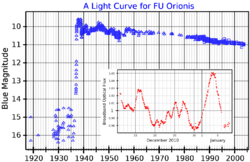Astronomy:FU Orionis
 The blue band light curve for FU Orionis, adapted from Clarke et al. (2005).[1] The inset plot, adapted from Siwak, et al. (2013),[2] illustrates the short timescale variability. | |
| Observation data Equinox J2000.0]] (ICRS) | |
|---|---|
| Constellation | Orion |
| Right ascension | 05h 45m 22.362s[3] |
| Declination | +09° 04′ 12.31″[3] |
| Apparent magnitude (V) | 8.94[3] |
| Characteristics | |
| Spectral type | uncertain + K5+2 −1[4] |
| B−V color index | 1.41[3] |
| Variable type | FU Ori[5] |
| Astrometry | |
| Proper motion (μ) | RA: 2.218 ± 0.079[6] mas/yr Dec.: -2.834 ± 0.065[6] mas/yr |
| Parallax (π) | 2.4029 ± 0.0497[6] mas |
| Distance | 1,360 ± 30 ly (416 ± 9 pc) |
| Details | |
| FU Orionis north | |
| Mass | 0.6[7] M☉ |
| FU Orionis south | |
| Mass | 1.2[4] M☉ |
| Temperature | 4350[4] K |
| Age | ~2[4] Myr |
| Other designations | |
| Database references | |
| SIMBAD | data |
FU Orionis is a variable and binary star[8] system in the constellation of Orion, that in 1937 rose in apparent visual magnitude from 16.5 to 9.6, and has since been around magnitude 9.[9][3] The name FU Orionis is a variable star designation in the Argelander system, which are assigned sequentially as new variables are discovered.[10] FU Orionis is about 1,360 light years distant and is associated with the molecular cloud Barnard 35.[6][11]
For a long time this variable was considered unique, but in 1970 a similar star, V1057 Cygni, was discovered, and a number of additional examples have been discovered since then. These stars constitute the FU Orionis class of variable stars, GCVS type FU, often nicknamed FUors. These stars are pre–main sequence stars which display an extreme change in magnitude and spectral type.
Stellar system
FU Orionis consists of two components, both surrounded by a circumstellar disk. Both disks were resolved with ALMA. The primary is surrounded by a dust disk with a radius of 11 astronomical units and the secondary disk has a similar inclination and size. The disks are separated by about 250 au. The 12CO emission show a complex kinematic environment and signatures of disk rotation, which are asymmetric. The asymmetry of the disk rotation is explained with interactions of the disks during a stellar flyby.[7]
The primary, called FU Orionis north has a mass of 0.6 M☉ and accretes M☉ per year.[7] The primary has an uncertain spectral type and luminosity class.[4] FU Orionis stars do not show strong emission lines during the outburst and have spectral features that resemble F- or G-type supergiants during the maximum. The outer parts of FU Orionis stars produce a K-M supergiant spectrum, which can be observed in the near-infrared.[12] The secondary, called FU Orionis south could be the more massive component in the system with 1.2 M☉ and a spectral type of about K5.[4]
Nebula
FU Orionis is associated with the molecular cloud Barnard 35 (part of the Lambda Orionis Ring) and close to the star an arc-shaped nebula is visible. Other FU Orionis stars are associated with an arc-shaped reflection nebula that becomes visible as the star brightens.[13][11]
References
- ↑ Clarke, C.; Lodato, G.; Melnikov, S. Y.; Ibrahimov, M. A. (August 2005). "The photometric evolution of FU Orionis objects: disc instability and wind–envelope interaction". Monthly Notices of the Royal Astronomical Society 361 (3): 942–954. doi:10.1111/j.1365-2966.2005.09231.x. Bibcode: 2005MNRAS.361..942C.
- ↑ Siwak, Michal; Rucinski, Slavek M.; Matthews, Jaymie M.; Kuschnig, Rainer; Guenther, David B.; Moffat, Anthony F. J.; Rowe, Jason F.; Sasselov, Dimitar et al. (June 2013). "Photometric variability in FU Ori and Z CMa as observed by MOST". Monthly Notices of the Royal Astronomical Society 432 (1): 194–199. doi:10.1093/mnras/stt441. Bibcode: 2013MNRAS.432..194S.
- ↑ 3.0 3.1 3.2 3.3 3.4 3.5 "V* FU Ori". SIMBAD. Centre de données astronomiques de Strasbourg. http://simbad.u-strasbg.fr/simbad/sim-basic?Ident=V%2A+FU+Ori.
- ↑ 4.0 4.1 4.2 4.3 4.4 4.5 Beck, Tracy L.; Aspin, C. (March 2012). "The Nature and Evolutionary State of the FU Orionis Binary System" (in en). The Astronomical Journal 143 (3): 55. doi:10.1088/0004-6256/143/3/55. ISSN 0004-6256. Bibcode: 2012AJ....143...55B.
- ↑ FU Ori, database entry, The combined table of GCVS Vols I-III and NL 67-78 with improved coordinates, General Catalogue of Variable Stars , Sternberg Astronomical Institute, Moscow, Russia. Accessed on line December 8, 2008.
- ↑ 6.0 6.1 6.2 6.3 Gaia Collaboration (2018-08-01). "Gaia Data Release 2 - Summary of the contents and survey properties" (in en). Astronomy & Astrophysics 616: A1. doi:10.1051/0004-6361/201833051. ISSN 0004-6361. Bibcode: 2018A&A...616A...1G.
- ↑ 7.0 7.1 7.2 Pérez, Sebastián; Hales, Antonio; Liu, Hauyu Baobab; Zhu, Zhaohuan; Casassus, Simon; Williams, Jonathan; Zurlo, Alice; Cuello, Nicolás et al. (January 2020). "Resolving the FU Orionis System with ALMA: Interacting Twin Disks?" (in en). Astrophysical Journal 889 (1): 59. doi:10.3847/1538-4357/ab5c1b. ISSN 0004-637X. Bibcode: 2020ApJ...889...59P.
- ↑ Wang, Hongchi; Apai, Dániel; Henning, Thomas; Pascucci, Ilaria (January 2004). "FU Orionis: A Binary Star?" (in en). Astrophysical Journal Letters 601 (1): L83–L86. doi:10.1086/381705. ISSN 0004-637X. Bibcode: 2004ApJ...601L..83W.
- ↑ AAVSO: FU Orionis
- ↑ Townley, S. D. (December 1915). "Designation of Variable Stars". Publications of the Astronomical Society of the Pacific 27 (161): 209. doi:10.1086/122431. Bibcode: 1915PASP...27..209T.
- ↑ 11.0 11.1 Smith, H. A.; Thronson, H. A.; Lada, C. J.; Harper, D. A.; Loewenstein, R. F.; Smith, J. (July 1982). "Far-infrared observations of FU Ori." (in en). Astrophysical Journal 258: 170–176. doi:10.1086/160065. ISSN 0004-637X. Bibcode: 1982ApJ...258..170S.
- ↑ Siwak, Michał; Winiarski, Maciej; Ogłoza, Waldemar; Dróżdż, Marek; Zoła, Stanisław; Moffat, Anthony F. J.; Stachowski, Grzegorz; Rucinski, Slavek M. et al. (October 2018). "Insights into the inner regions of the FU Orionis disc" (in en). Astronomy & Astrophysics 618: A79. doi:10.1051/0004-6361/201833401. ISSN 0004-6361. Bibcode: 2018A&A...618A..79S.
- ↑ "FU Orionis | aavso.org". https://www.aavso.org/vsots_fuori.
External links
- AAVSO Variable Star of the Month. FU Ori: February 2002
- FU Orionis at NightSkyInfo.com
 |

